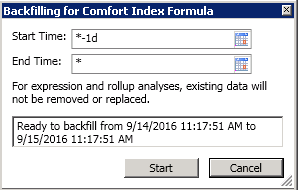Dear all,
I'm trying to set backfill programmatically for selected AF element/analyses.
I found very good forum discussion here Re: Get Results from Analysis without defining an Output Attribute
I have two questions:
1. In pi explorer creating backfill is easy, you set start date and end date and click start:

But it seems sdk doesn't give an easy high level api to do this, and aforementioned example confirms it. You need to calculate intervals manually and then run calculation for each interval...
Is it correct, maybe there is some other approach?
2. If we are talking about web api. Say I'd like to expose method in the web api which creates backfill data for particular element/analyses.Here always rely on time (of execution) when response is sent back to the caller, and most important is the time limited by timeout settings. For example if I want to get backfill for recent 2 years with interval 15 minutes, as a caller I'll never get a result, since either timeout happens or something else can go wrong during super long call. What is the right way to provide backfill functionality in the web api?
Thank you in advance.
Maxim.


